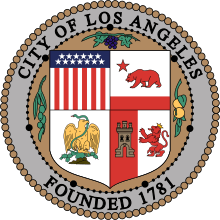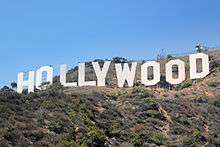Nichols Canyon, Los Angeles
Nichols Canyon is a residential area in the Hollywood Hills in Los Angeles, California, lying between Hollywood Boulevard on the south and Mulholland Drive on the north. It was also known as Miller Canyon.
History
Ownership
Nichols Canyon was named after John Gregg Nichols Jr., reputed to be "the first child born of American parents in Los Angeles" (in 1851). Nichols' ranch in the canyon was referred to as a "goat pasture."[1] [2][3][4]
Jacob Miller, a "pioneer avocado grower,"[5] and his wife, Dorothy, bought seventy acres of the property in 1879, and the area became known as Miller Canyon.[3][6] Mrs. Miller said in 1926:
Of course we had many hardships, not the least of which was having to drive through dust in summer and mud in winter to the hamlet of Los Angeles for our mail and supplies. There was nothing where Hollywood is now except a small ranch house. But we loved the hills and our beautiful canyon and were happy in our home and family."[6]
Roadway
Nichols Canyon Road, leading north from Hollywood Boulevard, was completed to Mulholland Highway via Courtney Street in 1925.[7] In 1926 the Automobile Club of Southern California reported that Nichols Canyon was traversed by a "good dirt road."[8]
In 1929, plans were made to widen the Nichols Canyon thoroughfare to serve "as a major gateway for traffic flowing between North Hollywood, Burbank, San Fernando Valley cities, Pasadena and West Hollywood." The idea was to widen the roadway, referred to as a northward "extension" of Genesee Street, to 46 feet, "with six inches of asphaltic concrete, through Hollywood Boulevard Estates to Mullholland High Way." Work would include "sewers, water, gas, lights, storm drains and electroliers." Grading of the Nichols Canyon road had already been "completed and paid for by individual property owners, who have installed water connections the full length of the thoroughfare."[9]
A 1930 report also stated that the canyon road would be renamed Genesee and would be extended north "to the Hollywood Boulevard Estates property line on Mulholland High Way." It was to be "developed as the main west lane of traffic through the hills" and would be "comparable with Cahuenga Pass, the main east channel."[9]
Afforestation
The beginning
In 1914, the canyon had a "sparkling stream which the trail crosses about twenty times" and which "splashes over rocks fifty feet high," forming a pool below.[10]
It was Dorothy Miller who was responsible for the exotic trees and shrubbery that eventually came to blanket Nichols Canyon. She planted and nurtured tropical seeds which an uncle gave her. They would not grow in the climate of his nursery in Downtown Los Angeles "but grew wonderfully in the frostless foothill belt." The Millers used Chinese laborers.[3][6]
The Los Angeles Times said, "It was due to the love of a woman for plants, in a day when it was not fashionable for ladies to garden, that most of the subtropical plantings in Nichols Canyon, or Miller Canyon, as it is sometimes called, were begun."[3]
The result
In 1997, James Sowell, the manager of environmental compliance for the Los Angeles Metropolitan Transit Authority noted the natural beauty of the three-mile-long canyon: "It's spectacular," he said. "The water comes down from two different directions. If you've driven up Nichols Canyon, part of it looks like a rain forest."[11]
Flora in the area by the end of the 20th century included Western sycamore, acacia, laurel sumac and California holly. "Lush canyon bottoms," said the Los Angeles Times, "made a carpet of verdure which became "oases for wildlife."[11]
Fires
Brush fires have struck the canyon over the years. One fire in 1904 was reported to have "utterly devastated" not only Nichols Canyon but also "Laurel Canyon adjacent to it," "many square miles" being "denuded of timber and all vegetation."[12] A fire was extinguished on an extension road in Astral Drive between Curson and Nichols Canyon in September 1956.[13] Three years later, residents had to flee another blaze that whipped through Laurel land Nichols canyons and destroyed homes.[14]
Fire believed started in a homeless encampment, or by a homeless man cooking dinner in the brush above Hollywood Boulevard, threatened between forty and sixty homes in August 2005 but was quelled by firefighters.[15][16]
Flood control
In 1913 the canyon was centered by a natural channel, or a wash, which crossed Sunset Boulevard at the south. A storm on February 25 of that year washed out the crossing.[17]
Homes in Nichols Canyon suffered major damage or were swept away when a rainstorm drenched Southern California on New Year's Day, 1931. The next August, the City Council allocated $46,000 for a large debris basin at the foot of the canyon, which residents had sought for years.[18]
In 1981 Nichols Canyon, as well as Laurel Canyon, Mandeville Canyon and Bandini Canyon, was threatened by the possibility of heavy rain damage when it was revealed that the city lacked funds to continue with flood-control projects.[19] The Los Angeles Times reported:
Ironically, funds were once available to correct the major flood-control problem in Nichols Canyon. But the repeated opposition of canyon residents to construction of a storm-drain system serving the length of Nichols Canyon Road caused the city to divert funds elsewhere.[20]
Satanite
In 1908, the Los Angeles County Board of Supervisors approved the establishment of a factory in the canyon to manufacture an explosive called Satanite, even after "Hollywood citizens and representatives of civic bodies" had protested. The approval followed demonstrations of the safety of the new product by company officials while a crowd of a hundred watched.[21][22][23]
Quarries
Complaints were raised in 1912 about dust from the quarries in Nichols Canyon. The City Council ordered the road closed, but "this was not satisfactory."[24] The quarry owners agreed to "furnish free of cost and spread upon the street the necessary gravel and crushed rock, and the city will oil the street."[25]
Subway water diversion
In 1997, Nichols Canyon residents reached a settlement with the Los Angeles Metropolitan Transit Authority because, the residents said, the construction of a subway through Hollywood was drying up the foliage in the canyon and surrounding areas. Pumping of water flooding the tunnel beneath the Santa Monica Mountains was draining the entire Hollywood basin of up to a third of its annual capacity.[11] Resident John Chickering said: "It was unbelievable. I looked out of my window one morning, and the falls were no more. The water had stopped. It was like a curse."[11]
Police activity
In 1924, policemen from the Hollywood Station "rigged up a range in Nichols Canyon . . . where they can shoot against a wall of earth with perfect safety to others."[26]
A score of police officers "beat the brush of isolated Nichols Canyon Road" on August 17, 1951, in an unsuccessful effort to find two .38-caliber revolvers that were used in the gangland killing of Tony Trambino and Tony Brancato just eleven days before. They searched "Beside the winding roadway [where] runs a densely overgrown culvert which at places deepens to a 30-foot ditch and elsewhere widens into the enormous unused Nichols Canyon Reservoir."[27]
Boy Scout camp
A Boy Scout camp was operating in the canyon as early as 1918, the year that Arthur Letts bought property for a permanent camp at a cost of $6,000.[28][29]
Notable residents
- Charles Coburn, actor[14]
- Susan Cummings, actor[14]
- Kaz Kuzui, film producer[30]
- Luciana Paluzzi, actor[14]
- Stephen Merchant, actor[31]
External links
References
- "Los Angeles' Eldest Son Dies in Mexico," Los Angeles Times, July 21, 1916, image 12
- Iva Berthelot Wood, "Early Events in History of Metropolis Recorded: Our First-Born," Los Angeles Times, March 27, 1927, image 35
- Alice Koons, "They Were Her Pets," Los Angeles Times, images 91 and 92
- "Son of First Mayor Dies," Los Angeles Times, December 14, 1937, image 28
- Ernest Braunton, "The Garden Beautiful in Southern California," Los Angeles Times, May 6, 1923, image 173 (with photos)
- Jane Frederickson, "First Hollywood Settlers Went There to Raise Vegetables," Los Angeles Times, March 14, 1926, image 34
- "Los Altos Park Is Subdivided," Los Angeles Times, November 29, 1925, image 109
- "Weekly Road Report," San Bernardino Daily Sun, February 14, 1926, image 14
- "Major Gateway Assured," Los Angeles Times, December 22, 1929, image 54
- [https://www.newspapers.com/image/380195472/?terms=Miller%2BCanyon "Canyon Parties," Los Angeles Times, April 14, 1914, image 18]
- Frank Clifford and Richard Simon, "Tunneling Is Drying Up L.A. Canyons, Experts Caution," Los Angeles Times, August 10, 1997, image 170 (with illustrations)
- "Forest Fire Near Los Angeles," Salinas Daily Index, Monterey County, California, September 30, 1904, page 1
- "Brush Fire Near Homes Extinguished," Los Angeles Times, September 11, 1956, image 2
- "Laurel Canyon Fire Rages; Hundreds Flee for Lives," Los Angeles Times, July 11, 1959, image 2 (with map)
- "Firefighters Contain Hollywood Hills Blaze; No Injuries Reported," Los Angeles Times, August 10, 2005, image 74 (with map and photo)
- Hector Becerra and Jessica Gresko, "Fire Brings the Focus to Homeless,' Los Angeles Times, August 11, 2005, image 159 (with photo)
- "Houses Flooded: Resort to Dynamite," Los Angeles Times, February 26, 1913, image 19
- "Nichols Canyon Fund Allotted," Los Angeles Times, September 1, 1934, image 21
- Josh Getlin, "Threats to Canyons: If It's Not Floods, It's Condo Development," Los Angeles Times, January 15, 1981, images 256 and 261
- Josh Getlin, "Canyons: 'Critical Danger' Feared in Storms," Los Angeles Times, January 15, 1981, image 261
- "Oppose Establishment of 'Satanite' Factory," Los Angeles Herald, November 24, 1908, image 12
- "Witness Tests of 'Satanite,'" Los Angeles Herald, November 26, 1908, image 8
- "'Satanite' Factory Will Be Built in Canyon," Los Angeles Herald, December 1, 1908, image 8
- "Bronson Avenue May Be a Boulevard," Los Angeles Times, November 22, 1912, image 28
- "City Hall Brevities," Los Angeles Times, December 27, 1912, image 24
- "Police Need Pistol Work," Los Angeles Times, January 28, 1924, image 22
- "Gang Murder Guns Hunted in Canyon," Los Angeles Times, August 18, 1951, image 2
- "Acreage Sales," Los Angeles Times, September 30, 1917, image 76
- "Would Honor President," Los Angeles Times, November 9, 1918, image 116
- "Hot Property," Los Angeles Times, January 27, 2002
- Stephen Merchant snags L.A. home, variety.com; accessed 8 March 2015.

